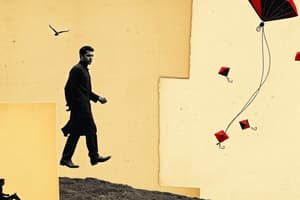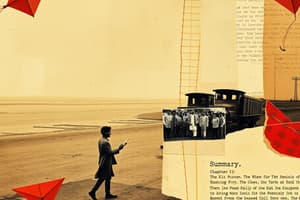Podcast
Questions and Answers
What do the buildings and streets of Kabul look like?
What do the buildings and streets of Kabul look like?
Rubble, everything is in ruins; fatherless children are left to beg on the corners of every street.
What metaphor is used on page 246?
What metaphor is used on page 246?
Jadeh Maywand had turned into a giant sand castle.
What is the metaphor comparing?
What is the metaphor comparing?
Comparing the street that used to sell kites is now full of buildings that barely stood, with caved in roofs and walls pierced with rocket shells.
What do the Taliban look like?
What do the Taliban look like?
Who is the old beggar that they run into?
Who is the old beggar that they run into?
What does the old beggar give Amir?
What does the old beggar give Amir?
What does Zaman who is in charge of the orphanage share about Sohrab?
What does Zaman who is in charge of the orphanage share about Sohrab?
Does the Zaman who is in charge of the orphanage let Amir in?
Does the Zaman who is in charge of the orphanage let Amir in?
What are the conditions of the orphanage?
What are the conditions of the orphanage?
Where is Sohrab?
Where is Sohrab?
What do the Taliban soldiers come for every month?
What do the Taliban soldiers come for every month?
What is Farid's reaction?
What is Farid's reaction?
Where can Amir locate the man who comes by every few months?
Where can Amir locate the man who comes by every few months?
Study Notes
Setting of Kabul
- Buildings and streets are in ruins, portrayed as rubble; left with fatherless children begging.
- A metaphor describes Jadeh Maywand as a "giant sand castle," highlighting destruction.
Metaphorical Comparison
- The vibrant kite-selling street has transformed into a desolate area, characterized by buildings with caved roofs and walls marked by rocket shells.
Appearance of the Taliban
- Taliban members are depicted with distinctive beards, black turbans, and armed with Kalashnikov rifles.
Encounter with the Beggar
- Amir and his companion meet an old beggar, a former professor who once worked alongside Amir's mother.
- The beggar provides Amir with valuable insights about his mother, surpassing what he learned from his father.
Information about Sohrab
- Zaman, the orphanage keeper, mentions Sohrab is exceptional with a slingshot and carries it everywhere.
Access to the Orphanage
- Amir is allowed into the orphanage after pleading and claiming a familial connection as Sohrab's "half-uncle."
Orphanage Conditions
- Living conditions are dire: lack of hot water, insufficient food, no heating, and complete negligence from the Taliban.
Sohrab's Situation
- Sohrab has been taken by a Taliban official a month prior to Amir's arrival.
Taliban's Monthly Demands
- Taliban soldiers visit monthly to take a boy from the orphanage; Zaman is forced to comply under threat of death.
Farid's Reaction
- Out of anger and frustration, Farid attacks Zaman, nearly strangling him until Amir intervenes.
Locating the Abductor
- Amir learns to locate the man who takes boys from the orphanage at Ghazi Stadium, the site of the national soccer team's games.
Studying That Suits You
Use AI to generate personalized quizzes and flashcards to suit your learning preferences.
Description
Test your knowledge of Chapter 20 from 'The Kite Runner'. This quiz covers metaphors and imagery as well as the depiction of Kabul's environment post-war. Enhance your understanding of the text and its deeper meanings through these flashcards.




